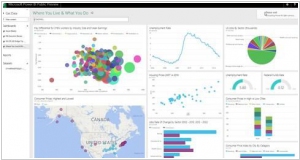Microsoft Power BI vs Zoho Analytics
March 19, 2025 | Author: Michael Stromann
30★
Power BI transforms your company's data into rich visuals for you to collect and organize so you can focus on what matters to you. Stay in the know, spot trends as they happen, and push your business further.
4★
Zoho Analytics (previously, Zoho Reports) is a self-service BI and data analytics software that lets you create visually appealing data visualizations and insightful dashboards in minutes.
Microsoft Power BI and Zoho Analytics, despite their differences, are like two intergalactic bureaucracies competing to see who can make the best charts before lunch. Both live in the cloud, happily slurping up data from a multitude of sources, whether it's a database, a spreadsheet or an unfortunate intern’s handwritten notes. They provide dazzling dashboards, AI-generated insights that may or may not be prophetic and pricing models that make you question your life choices. Naturally, they also come in both free and "we'd like some of your money now" versions, ensuring that everyone gets a taste before full commitment.
Power BI, created by Microsoft in 2015, is essentially the hyper-intelligent offspring of Excel that decided it wanted a more exciting life. It thrives in the corporate jungle, where large enterprises and spreadsheet wizards need deep integration with Azure, SQL Server and other mysterious artifacts from Microsoft’s empire. It speaks in the strange tongue of DAX, a formula language so powerful that even those who understand it wish they didn’t. While it grudgingly allows you to run reports on-premises, true collaboration requires a Pro or Premium subscription, which, in financial terms, translates roughly to “a little more than you wanted to spend.”
Zoho Analytics, born in 2009 under the warm sun of India, is the scrappy underdog that prefers a more relaxed, affordable approach. It cheerfully caters to small and mid-sized businesses, offering self-service analytics with fewer existential crises. If you happen to be using Zoho CRM, Zoho Books or any other Zoho-named entity, this tool will wrap itself around them like a particularly affectionate octopus. It also lets you embed analytics into your own software, a feature Power BI only considers after a long and dramatic sigh. Unlike its Microsoft rival, Zoho Analytics presents a pricing structure that doesn’t require deep meditation, making it a friendlier choice for those who prefer spending money on things like food.
See also: Top 10 Business Intelligence software
Power BI, created by Microsoft in 2015, is essentially the hyper-intelligent offspring of Excel that decided it wanted a more exciting life. It thrives in the corporate jungle, where large enterprises and spreadsheet wizards need deep integration with Azure, SQL Server and other mysterious artifacts from Microsoft’s empire. It speaks in the strange tongue of DAX, a formula language so powerful that even those who understand it wish they didn’t. While it grudgingly allows you to run reports on-premises, true collaboration requires a Pro or Premium subscription, which, in financial terms, translates roughly to “a little more than you wanted to spend.”
Zoho Analytics, born in 2009 under the warm sun of India, is the scrappy underdog that prefers a more relaxed, affordable approach. It cheerfully caters to small and mid-sized businesses, offering self-service analytics with fewer existential crises. If you happen to be using Zoho CRM, Zoho Books or any other Zoho-named entity, this tool will wrap itself around them like a particularly affectionate octopus. It also lets you embed analytics into your own software, a feature Power BI only considers after a long and dramatic sigh. Unlike its Microsoft rival, Zoho Analytics presents a pricing structure that doesn’t require deep meditation, making it a friendlier choice for those who prefer spending money on things like food.
See also: Top 10 Business Intelligence software





